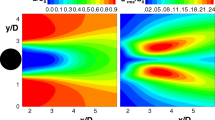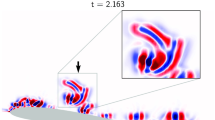Abstract
Triadic interactions are the fundamental mechanism of energy transfer in fluid flows. This work introduces bispectral mode decomposition as a direct means of educing flow structures that are associated with triadic interactions from experimental or numerical data. Triadic interactions are characterized by quadratic phase coupling which can be detected by the bispectrum. The proposed method maximizes an integral measure of this third-order statistic to compute modes associated with frequency triads, as well as a mode bispectrum that identifies resonant three-wave interactions. Unlike the classical bispectrum, the decomposition establishes a causal relationship between the three frequency components of a triad. This permits the distinction of sum- and difference-interactions, and the computation of interaction maps that indicate regions of nonlinear coupling. Three examples highlight different aspects of the method. Cascading triads and their regions of interaction are educed from direct numerical simulation data of laminar cylinder flow. It is further demonstrated that linear instability mechanisms that attain an appreciable amplitude are revealed indirectly by their difference-self-interactions. Applicability to turbulent flows and noise-rejection is demonstrated on particle image velocimetry data of a massively separated wake. The generation of sub- and ultra-harmonics in large eddy simulation data of a transitional jet is explained by extending the method to cross-bispectral information.















Similar content being viewed by others
References
Aubry, N., Holmes, P., Lumley, J.L., Stone, E.: The dynamics of coherent structures in the wall region of a turbulent boundary layer. J. Fluid Mech. 192, 115–173 (1988)
Baars, W.J., Tinney, C.E.: Proper orthogonal decomposition-based spectral higher-order stochastic estimation. Phys. Fluids 26(5), 055112 (2014)
Brès, G.A., Lele, S.K.: Modelling of jet noise: a perspective from large-eddy simulations. Philos. Trans. R. Soc. A 377(2159), 20190081 (2019)
Brillinger, D.R.: An introduction to polyspectra. Ann. Math. Stat. 36, 1351–1374 (1965)
Cheung, L.C., Zaki, T.A.: An exact representation of the nonlinear triad interaction terms in spectral space. J. Fluid Mech. 748, 175–188 (2014)
Collis, W., White, P., Hammond, J.: Higher-order spectra: the bispectrum and trispectrum. Mech. Syst. Signal Process. 12(3), 375–394 (1998)
Corke, T., Shakib, F., Nagib, H.: Mode selection and resonant phase locking in unstable axisymmetric jets. J. Fluid Mech. 223, 253–311 (1991)
Corke, T.C., Mangano, R.A.: Resonant growth of three-dimensional modes in trnsitioning Blasius boundary layers. J. Fluid Mech. 209, 93–150 (1989)
Craig, S.A., Humble, R.A., Hofferth, J.W., Saric, W.S.: Nonlinear behaviour of the mack mode in a hypersonic boundary layer. J. Fluid Mech. 872, 74–99 (2019)
Craik, A.: Non-linear resonant instability in boundary layers. J. Fluid Mech. 50(2), 393–413 (1971)
Craik, A.D.D.: Wave Interactions and Fluid Flows. Cambridge University Press, Cambridge (1988)
Deane, A., Kevrekidis, I., Karniadakis, G.E., Orszag, S.: Low-dimensional models for complex geometry flows: application to grooved channels and circular cylinders. Phys. Fluids A 3(10), 2337–2354 (1991)
Domaradzki, J.A.: Nonlocal triad interactions and the dissipation range of isotropic turbulence. Phys. Fluids A 4(9), 2037–2045 (1992)
Domaradzki, J.A., Rogallo, R.S.: Local energy transfer and nonlocal interactions in homogeneous, isotropic turbulence. Phys. Fluids A 2(3), 413–426 (1990)
Drivas, T.D., Wunsch, S.: Triad resonance between gravity and vorticity waves in vertical shear. Ocean Model. 103, 87–97 (2016)
Farazmand, M., Sapsis, T.P.: A variational approach to probing extreme events in turbulent dynamical systems. Sci. Adv. 3(9), e1701533 (2017)
Farazmand, M., Sapsis, T.P.: Closed-loop adaptive control of extreme events in a turbulent flow. Phys. Rev. E 100(3), 033110 (2019)
Farrell, B.F., Ioannou, P.J.: Structural stability of turbulent jets. J. Atmos. Sci. 60(17), 2101–2118 (2003)
Farrell, B.F., Ioannou, P.J., Jiménez, J., Constantinou, N.C., Lozano-Durán, A., Nikolaidis, M.A.: A statistical state dynamics-based study of the structure and mechanism of large-scale motions in plane poiseuille flow. J. Fluid Mech. 809, 290–315 (2016)
Gee, K.L., Atchley, A.A., Falco, L.E., Shepherd, M.R., Ukeiley, L.S., Jansen, B.J., Seiner, J.M.: Bicoherence analysis of model-scale jet noise. J. Acoust. Soc. Am. 128(5), EL211–EL216 (2010)
Giannetti, F., Luchini, P.: Structural sensitivity of the first instability of the cylinder wake. J. Fluid Mech. 581, 167–197 (2007)
Goza, A., Colonius, T.: A strongly-coupled immersed-boundary formulation for thin elastic structures. J. Comput. Phys. 336, 401–411 (2017)
Hammack, J.L., Henderson, D.M.: Resonant interactions among surface water waves. Annu. Rev. Fluid Mech. 25(1), 55–97 (1993)
He, C., Watson, G.A.: An algorithm for computing the numerical radius. IMA J. Numer. Anal. 17(3), 329–342 (1997)
Herring, J.R.: Theoretical calculations of turbulent bispectra. J. Fluid Mech. 97(1), 193–204 (1980)
Herring, J.R., Métais, O.: Spectral transfer and bispectra for turbulence with passive scalars. J. Fluid Mech. 235, 103–121 (1992)
Horn, R.A., Johnson, C.: Topics in matrix analysis. Cambridge University Press, Cambridge (1991)
Janssen, P.A.E.M.: Nonlinear four-wave interactions and freak waves. J. Phys. Oceanogr. 33(4), 863–884 (2003)
Kim, K.I., Powers, E.J.: A digital method of modeling quadratically nonlinear systems with a general random input. IEEE Trans. Acoust. Speech Signal Process. 36(11), 1758–1769 (1988)
Kim, Y.C., Powers, E.J.: Digital bispectral analysis and its applications to nonlinear wave interactions. IEEE Trans. Plasma Sci. 7(2), 120–131 (1979)
Kim, Y.C., Beall, J.M., Powers, E.J., Miksad, R.W.: Bispectrum and nonlinear wave coupling. Phys. Fluids 23(2), 258–263 (1980)
Kraichnan, R.H.: Inertial ranges in two-dimensional turbulence. Phys. Fluids 10(7), 1417–1423 (1967)
Kraichnan, R.H.: Inertial-range transfer in two-and three-dimensional turbulence. J. Fluid Mech. 47(3), 525–535 (1971)
Lii, K.S., Rosenblatt, M., Van Atta, C.: Bispectral measurements in turbulence. J. Fluid Mech. 77(1), 45–62 (1976)
Lumley, J.L.: Stochastic Tools in Turbulence. Academic Press, New York (1970)
Manz, P., Ramisch, M., Stroth, U., Naulin, V., Scott, B.D.: Bispectral experimental estimation of the nonlinear energy transfer in two-dimensional plasma turbulence. Plasma Phys. Control. Fusion 50(3), 035008 (2008)
Marston, J., Chini, G., Tobias, S.: Generalized quasilinear approximation: application to zonal jets. Phys. Rev. Lett. 116(21), 214501 (2016)
McKeon, B.J.: The engine behind (wall) turbulence: perspectives on scale interactions. J. Fluid Mech. 817, P1 (2017)
Moffatt, H.K.: Note on the triad interactions of homogeneous turbulence. J. Fluid Mech. 741, R3 (2014)
Nikias, C.L., Mendel, J.M.: Signal processing with higher-order spectra. IEEE Signal Process. Mag. 10(3), 10–37 (1993)
Nikias, C.L., Raghuveer, M.R.: Bispectrum estimation: a digital signal processing framework. Proc. IEEE 75(7), 869–891 (1987)
Noack, B.R., Afanasiev, K., Morzyński, M., Tadmor, G., Thiele, F.: A hierarchy of low-dimensional models for the transient and post-transient cylinder wake. J. Fluid Mech. 497, 335–363 (2003)
Phillips, O.M.: On the dynamics of unsteady gravity waves of finite amplitude part 1. The elementary interactions. J. Fluid Mech. 9(2), 193–217 (1960)
Pope, S.B.: Turbulent Flows, 1st edn. Cambridge University Press, Cambridge (2000)
Rigas, G., Oxlade, A., Morgans, A., Morrison, J.: Low-dimensional dynamics of a turbulent axisymmetric wake. J. Fluid Mech. 755 (2014)
Rigas, G., Sipp, D., Colonius, T.: Non-linear input/output analysis: application to boundary layer transition.. arXiv:2001.09440 (2020)
Ritz, C.P., Powers, E.: Estimation of nonlinear transfer functions for fully developed turbulence. Physica D 20(2–3), 320–334 (1986)
Rowley, C.W., Mezić, I., Bagheri, S., Schlatter, P., Henningson, D.S.: Spectral analysis of nonlinear flows. J. Fluid Mech. 641, 115–127 (2009)
Sapsis, T.P.: Statistics of extreme events in fluid flows and waves. Annu. Rev. Fluid Mech. 53 (2020), 85–111
Schmid, P., Henningson, D.S.: Stability and transition in shear flows. In: Applied Mathematical Sciences vol. 142, 1st edn. Springer, New York (2001)
Schmid, P.J.: Dynamic mode decomposition of numerical and experimental data. J. Fluid Mech. 656, 5–28 (2010). https://doi.org/10.1017/S0022112010001217
Schmidt, O.T., Colonius, T.: Guide to spectral proper orthogonal decomposition. AIAA J. 58(3), 1023–1033 (2020)
Sefusatti, E., Crocce, M., Pueblas, S., Scoccimarro, R.: Cosmology and the bispectrum. Phys. Rev. D 74(2), 023522 (2006)
Sirovich, L.: Turbulence and the dynamics of coherent structures. Q. Appl. Math. 45(3), 561–571 (1987)
Soomere, T.: Rogue waves in shallow water. Eur. Phys. J. Spec. Top. 185(1), 81–96 (2010)
Strykowski, P.J., Sreenivasan, K.R.: On the formation and suppression of vortex ‘shedding’at low reynolds numbers. J. Fluid Mech. 218, 71–107 (1990)
Thomas, V.L., Binh, K., Jovanović, M.R., Farrell, B.F., Ioannou, P.J., Gayme, D.F.: Self-sustaining turbulence in a restricted nonlinear model of plane couette flow. Phys. Fluids 26(10), 105112 (2014)
Towne, A., Schmidt, O.T., Colonius, T.: Spectral proper orthogonal decomposition and its relationship to dynamic mode decomposition and resolvent analysis. J. Fluid Mech. 847, 821–867 (2018). https://doi.org/10.1017/jfm.2018.283
Waleffe, F.: The nature of triad interactions in homogeneous turbulence. Phys. Fluids A 4(2), 350–363 (1992)
Watson, G.A.: Computing the numerical radius. Linear Algebra Appl. 234, 163–172 (1996)
Welch, P.: The use of fast Fourier transform for the estimation of power spectra: a method based on time averaging over short, modified periodograms. IEEE Trans. Audio Electroacoust. 15(2), 70–73 (1967)
Williamson, C.: Vortex dynamics in the cylinder wake. Annu. Rev. Fluid Mech. 28(1), 477–539 (1996)
Yamada, T., Itoh, S.I., Inagaki, S., Nagashima, Y., Shinohara, S., Kasuya, N., Terasaka, K., Kamataki, K., Arakawa, H., Yagi, M., et al.: Two-dimensional bispectral analysis of drift wave turbulence in a cylindrical plasma. Phys. Plasmas 17(5), 052313 (2010)
Acknowledgements
I would like to thank Tim Colonius for pointing me to higher-order spectra, Ethan Pickering for pointing out the need to compute difference-interactions, Aaron Towne, Peter Schmid, Georgios Rigas and Tim Colonius for many helpful discussions, and the two anonymous referees for their very insightful comments. I gratefully acknowledge Karen Mulleners for providing the PIV data, Guillaume Brès for the LES data, and Andres Goza for helping with the DNS.
Author information
Authors and Affiliations
Corresponding author
Ethics declarations
Conflict of Interest
The authors declare that they have no conflict of interest.
Additional information
Publisher's Note
Springer Nature remains neutral with regard to jurisdictional claims in published maps and institutional affiliations.
Appendices
Appendix A: Computation of \(\mathbf{a }_1= \text {arg max}_{\Vert \mathbf{a }\Vert =1}|\mathbf{a} ^*\mathbf{B }\mathbf{a }|\)
A slightly modified version of the algorithm for the computation of the numerical radius by He and Watson [24] is used. He and Watson’s algorithm requires two nested iterations. The first, or so-called simple iteration [60], converges to a local solution of Eq. (56). A tolerance of \( tol =10^{-8}\) was found to be a good compromise between accuracy and compute time for both iterations. The number of iterations was limited to \(k=300\).

Building on the simple iteration to find local solutions, the purpose of the main algorithm is to find the global solution. Double precision arithmetic with machine precision \(\epsilon =2^{-52}\) was used to compute the results in Sect. 4. If the algorithm did not converge within 500 iterations, it was restarted up to five times with a new random initial guess for \(\mathbf{a} _0\). This procedure was necessary to ensure that all results are fully converged.

Appendix B: Convergence
Figure 16 demonstrates the convergence of all three cases discussed in Sect. 4 in terms of summed mode spectra. The convergence of the results is tested by recomputing the BMD for smaller subsets of the available data. In particular, Fig. 16a shows that the summed mode spectrum obtained for the first 3 and 5 blocks of the cylinder flow DNS data is very similar to the one obtained for all 7 block. Similarly, the full data of the flat plate PIV and the jet LES are compared to the spectra obtained for approximately one-third and two-thirds of the full data in Fig. 16b and c, respectively. It can be seen that the summed mode spectra for the latter cases, too, remain largely unaltered by the data reduction. The summed mode spectrum was chosen as the most compact representation of the results. A comparison of the bispectral modes and mode bispectra (not shown) obtained from the full and reduced data sets confirmed that the results are also well-converged with respect to mode spectra and mode shapes.
Rights and permissions
About this article
Cite this article
Schmidt, O.T. Bispectral mode decomposition of nonlinear flows. Nonlinear Dyn 102, 2479–2501 (2020). https://doi.org/10.1007/s11071-020-06037-z
Received:
Accepted:
Published:
Issue Date:
DOI: https://doi.org/10.1007/s11071-020-06037-z





